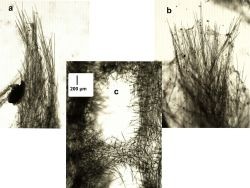orange
massive
papillated
spherical
soft
Colombia
Panama
Auletta cubensis
Description: Shape can be massive, consisting of clusters of laterally fused lobes-columns surrounding membranous areas with oscules; sometimes there can be groups of discrete, basally fused tube-shaped lobes, crown by membranous oscules; sometimes specimens are partly buried in sand with only lobes (round or pointed) showing above the substratum. The surface is rather irregular, hispid to conulose; when taken out of the water, the pinacoderm collapses leaving masses of laterally fused hispid columns. Size up to 5-10 cm wide and up to 5 cm high; oscules up to about 5 mm in diameter. Color bright orange. Consistency compressible, with the outer flesh soft and the spicule columns somewhat wiry, difficult to tear. Ectosome organic, supported by the ends of ascending spicule tracts. Skeleton made of thick, 125-800 µm, ascending and diverging plumose multispicular tracks, sometimes interconnected by other tracts. Tracts are made of style and strongyle spicules, and often echinated by styles pointing either perpendicular or diagonally upwards. Spicules in two types: (a) styles, slightly curved, slender, in a wide range of sizes, the smaller usually thicker, 320-1160 µm long by 8.7-16.7 µm thick; (b) strongyles, sinuously curved, 530-975 µm long (but may be longer) by 5-10 µm wide; developmental stages of both kinds of spicules can be as thin as 2.5 µm.
Notes: This species lives in deep reef settings, both exposed and in overhanging walls or caves, and partly buried in sand in between corals. Auletta cubensis was originally described as fist-sized erect masses of laterally fused lobes with terminal membranous oscules (Alcolado, 1984). The material depicted here, which comes from Santa Marta, Colombia, and Bocas del Toro, Panama, is quite more variable in shape, even including laterally fused tubes-lobes. We have identified these as belonging to A. cubensis from the orange color, the overall skeletal shape and the spicule complement (styles in the original material are 120-700 x 4-13 µm, strongyles, straight to flexuous, 110-995 x 4-13 µm). Material from the Bahamas, also with a quite varied shape and similar but thinner and smaller spicules, is included in this guide as a different species, still unidentified, under the man Auletta sp.-"orange bush-lobe-tube". Perhaps it is the same species and the smaller and thinner spicules can be ascribed to lower silicon contents in the offshore oceanic waters of the Bahamas vs. those of inshore or continental localities such as Cuba and the southern Caribbean (Zea, 1987). Further material and comparisons need to be made to clarify this issue. In addition, there are several species sharing the overall aspect of bright orange color and thin membranous pinacoderm stretched over raised columns of tissue and spicules, which are difficult to distinguish in the field. Apart from to the two Auletta, in this guide we include Dictyonella sp.2-"with oxea" and Dragmaxia undata Alvarez, van Soest & Rützler, 1998, that can be definitely distinguished by the spicules (very long styles in the former, styles and raphides in the latter). This species was originally described from Cuba under the genus Bubaris, and later transferred to Acanthella by Alvarez et al. (1998). We have moved it to Auletta because the current definition of Acanthella (van Soest et al., 2002) places it in family Dictyonellidae, and corresponds to sponges with a cartilage, shiny, tough and membranous surface which remains preserved in alcohol (B. Alvarez, pers. comm.). Its more hispidate surface, and the plumorectiulate skeleton with sinous strongyle spicules falls within the definition of Auletta (Alvarez & Hooper, 2002).
Author Reference: (Alcolado, 1984)
Link: World Porifera Database

![<i>Auletta cubensis</i> <br />[Colombia, Santa Marta]](mini/00116/01831.jpg)
![<i>Auletta cubensis</i> <br />[Colombia, Santa Marta]](mini/00116/01833.jpg)

